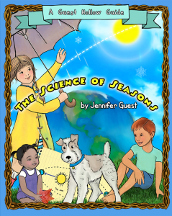The Science of Seasons is a delightful study of the seasons written and illustrated by Jennifer Guest. It can be used for children in grades one through six, but it is probably ideal for the middle of that range.
The book is gorgeously illustrated in full-color. The book was written with Christian homeschooling children in mind, but it’s not heavily Christian. For example, in the presentation about celebrations that happen in the Spring, it begins with Mother’s Day and Easter, but it also mentions a few other celebrations within other cultures and religions. You will find a few references to God and a few Bible verses, and no discussion of evolution. Children in the illustrations are modestly dressed, but they interact like normal children rather than “perfect” children.
The first part of this 50-page book teaches about seasons in general, using illustrated explanations and examples to which children can relate. Occasionally, lessons are presented in comic book fashion. Among topics in this section are the elliptical orbit of the earth, the rotation of the earth on its axis, the hemispheres of the earth, temperature variations, and weather.
The rest of the book teaches about the four seasons and the sorts of things we experience in each season. It also explains that some places don’t really experience seasons.
There are a few activities and recipes for “seasonal” foods in this book, but Guest has written The Science of Seasons Learn-and-Play Activities book that is loaded with hands-on learning activities that correlate with The Science of Seasons. This 125-page book has some science activities such as creating rain in a jar and recording and graphing the temperature. But it really offers more of a cross-curricular experience with mazes and puzzles, paper dolls, arts and crafts, copywork, map work, and even grammar activities. Many of the activities use full-color illustrations that are cut out from the pages of the book, so you should purchase the print version if you don’t have access to a color printer.
Some families will want to go deeper into the science topics, and Guest has created the free online companion “The Science of Seasons Curriculum” that does just that. The free curriculum covers topics such as animal camouflage, animal habitats, Earth’s magnetic poles, oceans, and plants. It is suitable for students in grades one through four, but grades two and three are ideal. The curriculum requires you to use The Science of Seasons and the Activities book plus some library books (or purchased books) as well as free online resources. The curriculum takes a unit study approach to each topic, covering science, language arts, Bible, art, music, and geography.
There are two options for the free curriculum. One is a 14-week study in which science and language arts dominate the learning activities. It uses books such as Explore Spring, The Greedy Triangle, Explore Earth’s Five Oceans, and Farmer Boy.
The second option allows you to arrange the curriculum to match the seasons as you experience them. It divides the material into a short “Pre-unit” that covers the general lesson material and four sections for the four seasons. This version of the curriculum has less work in the area of language arts and has a stronger emphasis on science. As with the other study, it incorporates an assortment of online resources and real books such as The Longest Day: Celebrating the Summer Solstice, Time for Kids: Volcanoes!, and The Story of Snow: The Science of Winter’s Wonder.
The first option lays out the curriculum in weekly chunks while the second option lays it out in only five sections. The latter option leaves it to parents to do more work figuring out what to do each week since the activities in the chart might be completed over a few months.
You can see samples of a generous number of pages from both The Science of Seasons and the Activities book on the Guest Hollow website. These should give you a good idea of what the curriculum is like. You really have to see it to appreciate the quality of the artwork!











